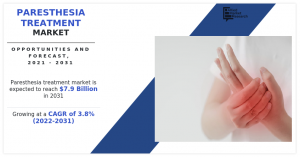Paresthesia Treatment Market: Heading for $7.9 Billion by 2031 — and New Therapies Are Already Reshaping the Landscape
The growth of paresthesia treatment market share is driven by rise in prevalence of disease such as cancer, surge in geriatric population, and lack of proper nutrients in the food. In addition, increase in prevalence of paresthesia among the population, poor lifestyle, and increase in healthcare expenditure would further supplement the paresthesia treatment market growth.
Executive Snapshot — Key Take‑aways
Market Expansion: Demand rises steadily on the back of an ageing global population, increased cancer prevalence, and growing awareness of neuropathic disorders.
Disease Burden Shift: Chronic paresthesia now dominates > 60 % of diagnosed cases, spurring long‑term pharmacological management needs.
Topical Formulations in Focus: Non‑systemic creams and gels contributed ~32 % of 2021 revenue thanks to easy OTC access and favourable safety profiles.
Retail Pharmacies Rule: Brick‑and‑mortar outlets accounted for ~45 % of global drug sales, reflecting convenience and patient trust.
North America Leads (2021 share ≈ 40 %): Strong payer coverage, specialist centres, and robust R&D pipelines underpin leadership.
White‑Space Opportunity: Asia‑Pacific is forecast to post the fastest regional CAGR (> 5 %) on the strength of rising disposable incomes and underdiagnosed patient pools.
Get a Sample Copy of this Report: https://www.alliedmarketresearch.com/request-sample/A17080
Market Drivers
Rising Neuropathic Complications of Cancer & Chemotherapy – Peripheral neuropathies are common side‑effects, enlarging the addressable market.
Geriatric Demographics – People aged ≥ 65 are at higher risk of nerve‑related sensations; the UN projects this cohort to double by 2050.
Dietary & Lifestyle Gaps – Urban diets low in B‑vitamins and chronic alcohol use elevate paresthesia incidence.
Healthcare Spend Uptrend – Expanding insurance coverage across emerging economies improves access to diagnostics and therapy.
Restraints & Challenges
Limited Drug Effectiveness – Conventional analgesics offer only symptomatic relief; sub‑optimal efficacy curbs long‑term adherence.
Stringent Regulatory Pathways – CNS‑acting agents face rigorous safety scrutiny, prolonging approval timelines and R&D costs.
Awareness Deficit in Low‑Income Regions – Underreporting of neuropathic symptoms delays intervention and skews epidemiological data.
Emerging Opportunities
Targeted Novel Mechanisms – R&D funds are flowing into ion‑channel modulators and micro‑RNA therapeutics aimed at nerve repair.
Digital Therapeutics & Remote Monitoring – Wearable neuro‑stimulation patches and mobile apps for symptom tracking promise adjunct revenue streams.
Strategic Partnerships – Pharma–biotech collaborations and academic consortia accelerate pipeline progression and market entry in niche sub‑segments.
Regional Outlook
North America
Comprehensive insurance reimbursement and 20+ active clinical trials ensure sustained dominance.
Europe
Strong regulatory harmonisation (EMA) and ageing population support mid‑single‑digit growth.
Asia‑Pacific
Highest unmet need; Chinese‑ and Indian‑led investments in generics and biosimilars expand access.
LAMEA
Gradual uptake; public‑private partnerships in Brazil and Saudi Arabia target diagnostic gaps.
Competitive Landscape (Illustrative)
Pfizer Inc. – Market leader in gabapentinoid class; exploring transdermal delivery platforms.
Teva Pharmaceutical – Robust generic pipeline; cost‑competitive topical lidocaine.
Grünenthal GmbH – Pioneering high‑concentration capsaicin patches for post‑herpetic neuralgia.
AbbVie – R&D on α‑calcitonin gene‑related peptide inhibitors for neuropathic symptom modulation.
Strategic Recommendations
Differentiate via Novel Delivery Routes: Invest in micro‑needle patches and sustained‑release implants to enhance patient compliance.
Leverage AI‑Driven Diagnostics: Integrate EMG data analytics and symptom‑tracking apps for earlier intervention and personalised dosing.
Expand Patient‑Support Ecosystems: Co‑pay assistance, tele‑counselling, and lifestyle coaching boost brand loyalty and real‑world outcomes.
Seek Fast‑Track Designations: For first‑in‑class agents targeting severe chronic paresthesia, accelerated FDA/EMA pathways can shave 6‑12 months off launch timelines.
Bottom Line
Although paresthesia remains largely a symptom rather than a standalone disease, its rising prevalence—particularly chronic forms linked to metabolic and neurologic disorders—creates a USD 2.5 billion incremental opportunity by 2031. Companies that blend innovative formulations, digital adjuncts, and strategic market access stand to capture outsized value in this moderate‑growth but under‑served therapeutic space.
Enquire Before Buying: https://www.alliedmarketresearch.com/purchase-enquiry/A17080
David Correa
Allied Market Research
+ 1800-792-5285
email us here
Visit us on social media:
LinkedIn
Facebook
YouTube
X
Legal Disclaimer:
EIN Presswire provides this news content "as is" without warranty of any kind. We do not accept any responsibility or liability for the accuracy, content, images, videos, licenses, completeness, legality, or reliability of the information contained in this article. If you have any complaints or copyright issues related to this article, kindly contact the author above.
THE WEATHER CHANNEL ANNOUNCES DEBUT OF "KATRINA 20"; A COMMEMORATIVE LOOK BACK AT HURRICANE KATRINA'S DEVASTATING IMPACT
Redefining Financial Reporting: Chartered Institute Launches CIFRS™ Certification for Financial and Accounting Leaders
DAM Fashion by Deborah Ann Mack Announces Re-Grand Opening and Fall 2025 Coat Preview
Więcej ważnych informacji
 Jedynka Newserii
Jedynka Newserii

 Jedynka Newserii
Jedynka Newserii

Handel

1 października ruszy w Polsce system kaucyjny. Część sieci handlowych może nie zdążyć z przygotowaniami przed tym terminem
Producenci, sklepy i operatorzy systemu kaucyjnego mają niespełna dwa miesiące na finalizację przygotowań do jego startu. Wówczas na rynku pojawią się napoje w specjalnie oznakowanych opakowaniach, a jednostki handlu powinny być gotowe na ich odbieranie. Część z nich jest już do tego przygotowana, część ostrzega przed ewentualnymi opóźnieniami. Jednym z ważniejszych aspektów przygotowań na te dwa miesiące jest uregulowanie współpracy między operatorami, których będzie siedmiu, co oznacza de facto siedem różnych systemów kaucyjnych.
Ochrona środowiska
KE proponuje nowy cel klimatyczny. Według europosłów wydaje się niemożliwy do realizacji

Komisja Europejska zaproponowała zmianę unijnego prawa o klimacie, wskazując nowy cel klimatyczny na 2040 roku, czyli redukcję emisji gazów cieplarnianych o 90 proc. w porównaniu do 1990 rok. Jesienią odniosą się do tego kraje członkowskie i Parlament Europejski, ale już dziś słychać wiele negatywnych głosów. Zdaniem polskich europarlamentarzystów już dotychczas ustanowione cele nie zostaną osiągnięte, a europejska gospodarka i jej konkurencyjność ucierpi na dążeniu do ich realizacji względem m.in. Stanów Zjednoczonych czy Chin.
Handel
Amerykańskie indeksy mają za sobą kolejny wzrostowy miesiąc. Druga połowa roku na rynkach akcji może być nerwowa

Lipiec zazwyczaj jest pozytywnym miesiącem na rynkach akcji i tegoroczny nie był wyjątkiem. Amerykańskie indeksy zakończyły go na plusie, podobnie jak większość europejskich. Rynki Starego Kontynentu nie przyciągają jednak już kapitału z taką intensywnością jak w pierwszej części roku. Z drugiej strony wyceny za oceanem po kolejnych rekordach są już bardzo wysokie, a wpływ nowego porządku celnego narzuconego przez Donalda Trumpa – na razie trudny do przewidzenia. W najbliższym czasie na rynkach można się spodziewać jeszcze większej zmienności i nerwowości, ale dopóki spółki pokazują dobre wyniki, przesłanek do zmiany trendu na spadkowy nie ma.
Partner serwisu
Szkolenia

Akademia Newserii
Akademia Newserii to projekt, w ramach którego najlepsi polscy dziennikarze biznesowi, giełdowi oraz lifestylowi, a także szkoleniowcy z wieloletnim doświadczeniem dzielą się swoją wiedzą nt. pracy z mediami.



![Nestlé w Polsce podsumowuje wpływ na krajową gospodarkę. Firma wygenerowała 0,6 proc. polskiego PKB [DEPESZA]](https://www.newseria.pl/files/1097841585/fabryka-nesquik_1,w_85,r_png,_small.png)




.gif)

 |
| |
| |
|